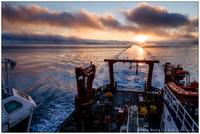
Historically, the existence of protective ice cover has shielded the Arctic Ocean from atmospheric storms, depriving it of a usual source of internal waves - propagating disturbances of the ocean’s density structure that can become unstable, break and mix the ocean interior. As a result, turbulent energy levels in the region have been much weaker than in other oceans, and thus vertical heat transport in the Arctic Ocean has been relatively modest. The rapid loss of protective ice cover during summer months, however, suggests that change may be afoot, with potentially profound consequences for the Arctic climate. And in considering the associated evolution of internal wave activity, a striking feature of the region that must be accounted for is the existence of complex stratifications, such as remarkable arrangements of meter-scale mixed layers separated by density jumps that are coherent over hundreds of kilometers and multiple years.
To investigate this evolving scenario, we consider the propagation of internal waves through density stratifications with multiple layers using the combination of analytical modeling, laboratory experiments, and in-situ measurements taken in the Arctic Ocean. The peculiar wave dynamics that arise induce nontrivial impacts and, furthermore, have a direct analogy with optical Fabry-Perot interferometry, facilitating the interpretation of our results.

